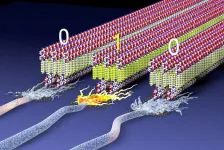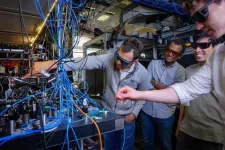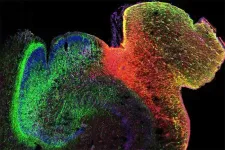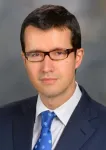(Press-News.org) Even if it is possible to reverse the rise of global temperatures after a temporary overshoot of 1.5°C, some climate damages inflicted at peak warming, including rising sea levels, will be irreversible, according to a new study published today in Nature.
The study is the culmination of a three-and-a-half-year project, backed by the European innovation fund HORIZON2020, looking at so-called ‘overshoot’ scenarios where temperatures temporarily exceed the Paris Agreement’s 1.5°C limit, before descending again by achieving net-negative CO2 emissions.
“This paper does away with any notion that overshoot would deliver a similar climate outcome to a future in which we had done more, earlier, to ensure to limit peak warming to 1.5°C,” explains Carl-Friedrich Schleussner, Integrated Climate Impacts Research Group Leader in the IIASA Energy, Climate, and Environment Program and scientific advisor at Climate Analytics, who led the study. “Only by doing much more in this critical decade to bring emissions down and peak temperatures as low as possible, can we effectively limit damages,” he adds.
It matters how high and for how long we let temperatures rise
The paper highlights that if we were to exceed 1.5°C there are clear benefits to reversing warming by acting to achieve net negative emissions globally. Achieving long-term temperature decline could lower sea level rise in 2300 by about 40 cm compared to a situation in which temperatures merely stopped rising.
“Until we get to net zero, warming will continue. The earlier we can get to net zero, the lower peak warming will be, and the smaller the risks of irreversible impacts,” notes study co-author Joeri Rogelj, professor of climate science and policy and Director of Research of the Grantham Institute at Imperial College London and senior research scholar in the IIASA Energy, Climate, and Environment Program. “This underscores the importance of countries submitting ambitious new reduction pledges, or so-called Nationally Determined Contributions (NDCs), well ahead of next year’s climate summit in Brazil.”
Full carbon dioxide removal capacity needed to hedge against higher warming
The study emphasizes that while there are still pathways open to limiting warming to 1.5°C or lower in the long run, there is a need to ‘hedge’ against higher warming outcomes if the climate system warms more than median estimates. To do this, ambitious emissions reductions need to go hand in hand with scaled and environmentally sustainable carbon dioxide removal technologies. A ‘preventive capacity’ of several hundred gigatons of net removals might be required.
“There’s no way to rule out the need for large amounts of net negative emissions capabilities, so we really need to minimize our residual emissions. We cannot squander carbon dioxide removal on offsetting emissions we have the ability to avoid,” commented study coauthor Gaurav Ganti, research assistant at IIASA and a research analyst at Climate Analytics.
“Our work reinforces the urgency of governments acting to reduce our emissions now, and not later down the line. The race to net zero needs to be seen for what it is – a sprint,” Schleussner concludes.
Reference
Schleussner, C-F., Ganti, G., Lejeune, Q., Zhu, B., Pfleiderer, P., Prütz, R., Ciais, P., Frölicher, T.L., Fuss, S., Gasser, T., Gidden, M.J., et al. (2024). Overconfidence in climate overshoot. Nature DOI: 10.1038/s41586-024-08020-9
About IIASA:
The International Institute for Applied Systems Analysis (IIASA) is an international scientific institute that conducts research into the critical issues of global environmental, economic, technological, and social change that we face in the twenty-first century. Our findings provide valuable options to policymakers to shape the future of our changing world. IIASA is independent and funded by prestigious research funding agencies in Africa, the Americas, Asia, and Europe. www.iiasa.ac.at
END
Scientists caution no guarantees when it comes to overshooting 1.5°C
2024-10-09
ELSE PRESS RELEASES FROM THIS DATE:
Nature and plastics inspire breakthrough in soft sustainable materials
2024-10-09
Step aside hard, rigid materials. There is a new soft, sustainable electroactive material in town — and it’s poised to open new possibilities for medical devices, wearable technology and human-computer interfaces.
Using peptides and a snippet of the large molecules in plastics, Northwestern University materials scientists have developed materials made of tiny, flexible nano-sized ribbons that can be charged just like a battery to store energy or record digital information. Highly energy efficient, biocompatible and made from sustainable materials, the systems could give rise to new ...
New quantum timekeeper packs several clocks into one
2024-10-09
Imagine walking into a room where several different grandfather clocks hang on the walls, each ticking at a different pace.
Quantum physicists at the University of Colorado Boulder and the National Institute of Standards and Technology (NIST) have essentially recreated that room at the scale of atoms and electrons. The team’s advancement could pave the way for new kinds of optical atomic clocks, devices that track the passage of time by measuring the natural “ticking” of atoms.
The group’s new clock is made from a few dozen strontium ...
Suicidal thoughts and behaviors among autistic transgender or gender-nonconforming US college students
2024-10-09
About The Study: This cross-sectional study addresses the dearth of information on how intersectionality in gender and autism status impacts the risk of suicidal thoughts and behaviors, and the results confirm the elevated risk of suicidal thoughts and behaviors among transgender or gender nonconforming and autistic populations. Interventions are needed to support college students with these identities.
Corresponding Author: To contact the corresponding author, Annabelle M. Mournet, MS, email amm883@psych.rutgers.edu.
To ...
The bright and dark sides of Pacific salmon biotransport
2024-10-09
Each year millions of Pacific salmon make a grand journey from the ocean to their freshwater spawning grounds at the end of their life cycles. This migration has rippling effects through food webs and ecosystems along the way. Whether they decompose or are consumed by other animals, these salmon deliver both nutrients and contaminants they have accumulated in their bodies after spending most of their lives growing at sea. A team of researchers from UConn, the University of South Dakota, the U.S. Geological Survey, Natural ...
New therapeutic strategy identified for triple negative breast cancer
2024-10-09
Triple negative breast cancer (TNBC) remains the most aggressive and deadly type of breast cancer, but new findings from cancer researchers at Brigham and Women’s Hospital, a founding member of the Mass General Brigham healthcare system, are pointing the way toward therapeutic strategies that could be tested in clinical trials in the future. Using patient-derived samples in pre-clinical work, researchers discovered that by combining two therapeutic agents they could nudge TNBC cells into a more treatable state. Findings are published in Nature.
“When combined, these therapeutic agents ...
Scientists create first map of DNA modification in the developing human brain
2024-10-09
A UCLA-led study has provided an unprecedented look at how gene regulation evolves during human brain development, showing how the 3D structure of chromatin — DNA and proteins — plays a critical role. This work offers new insights into how early brain development shapes lifelong mental health.
The study, published in Nature, was led by Dr. Chongyuan Luo at UCLA and Dr. Mercedes Paredes at UC San Francisco, in collaboration with researchers from the Salk Institute, UC San Diego and Seoul National University. It created the first map of DNA modification in the hippocampus and prefrontal cortex — two regions ...
Extended Timing: How neurons encode information on timescales that match learning
2024-10-09
New research from the Max Planck Florida Institute for Neuroscience published this week in Nature has identified a key step in how neurons encode information on timescales that match learning.
A timing mismatch
Learning takes seconds to minutes. However, the best-understood mechanisms of how the brain encodes information happen at speeds closer to neural activity—around 1000 times faster. These mechanisms, known as Hebbian plasticity, suggest that if two connected neurons are both active within a hundredth of a second, then the connection between the two neurons is strengthened. In this ...
Dual immunotherapy plus chemotherapy benefits specific subset of patients with lung cancer
2024-10-09
HOUSTON ―Researchers from The University of Texas MD Anderson Cancer Center have demonstrated that patients with metastatic non-squamous non-small cell lung cancer (NSCLC) harboring specific mutations in the STK11 and/or KEAP1 tumor suppressor genes were more likely to benefit from adding the immunotherapy tremelimumab to a combination of durvalumab plus chemotherapy to overcome treatment resistance typically seen in this patient population.
Study results, published today in Nature, identify ...
Scientists discover viral trapdoor blocking HIV and herpes
2024-10-09
Scientists discover viral trapdoor blocking HIV and herpes
Ghent, 10 October 2024 – A group of researchers led by Xavier Saelens and Sven Eyckerman at the VIB-UGent Center for Medical Biotechnology discovered how a protein linked to the human immune system wards off HIV-1 and herpes simplex virus-1 by assembling structures in the cell that lure in these viruses and then trap them or even take them apart. The research was spearheaded by first author George Moschonas, published in Cell Host and Microbe, and could be used to devise new strategies to combat these viruses.
The innate immune system of the human body can sense and respond to viruses by ...
Study uncovers mutations and DNA structures driving bladder cancer
2024-10-09
How bladder cancer originates and progresses has been illuminated as never before in a study led by researchers at Weill Cornell Medicine and the New York Genome Center. The researchers found that antiviral enzymes that mutate the DNA of normal and cancer cells are key promoters of early bladder cancer development, and that standard chemotherapy is also a potent source of mutations. The researchers also discovered that overactive genes within abnormal circular DNA structures in tumor cells genes drive bladder cancer resistance to therapy. These findings are novel insights into bladder cancer biology and point to new therapeutic strategies for this ...





